SDUSD Teacher Professional Development - 6th Grade - Earth Science
March 18th, 2009, Mission Bay High School
Presenter - Memorie Yasuda
Please note that content and links are provided for convenience only. While we do our best to check the quality of our content, we cannot guarantee that it is always correct. We try our best to correct errors as soon as they are brought to our attention so please let us know if you find an error. Hyperlinks that Earthguide provides to external websites do not imply official Earthguide endorsement of, or responsibility for, the content contained on those sites. Links are provided as a service to the user, and Earthguide does not retain editorial control over them. No endorsement of a product or a point-of-view should be inferred.
The atmosphere and its circulation
Atmosphere basics
Where air gets the energy to move
- Energy from the Sun fuels practically all the motion of air, water and life on the Earth, with the major exception being the motion of plates fueled by energy within the Earth.
- Energy is emitted by the Sun in the form of electromagnetic radiation that can travel through the near-vacuum of outer space. Sunlight is radiation.
- When sunlight encounters the Earth and its atmosphere, some of it collides with substances in the air returns to space by reflection, or it is temporarily absorbed and then emitted to space.
- Radiation absorbed by matter can raise the temperature of substances. That absorbing substance increases its energy.
- When that same energy is released by matter when it is emitted, energy is lost.
- There is a general balance between incoming and outgoing radiation to space so that the Earth's surface temperature stays relatively constant over time.
- The average temperature of the Earth's surface has varied over a small range over time depending on changes in the reflectivity of the Earth, solar output, and concentration of greenhouse gases in the atmosphere.
How air moves and why
- Air is mostly heated by the ground.
- When air is heated, it expands, separates from the ground and rises.
- As air rises, it encounters lower pressure and it expands and cools.
- The temperatues at elevation can become cool enough so that water vapor condenses into liquid water. That's how clouds form when moist air rises.
- As air moves upward, its temperature drops by about 6-10° C per 1,000 m.
- The average temperature of the Earth's surface has varied over a small range over time depending on changes in the reflectivity of the Earth, solar output, and concentration of greenhouse gases in the atmosphere.
Clouds and precipitation - where and how they form
- Clouds are made up of droplets of liquid or frozen water
- Clouds form when temperature and pressure conditions are just right for water vapor to change into the liquid of solid phase.
- Clouds form in the sky when air that contains water vapor moves to higher altitude where it is colder.
- Clouds form in places where air rises. The places where air rises are associated with low atmospheric pressure.
- Common places where air rises are over the ITCZ just north of the equator, at the polar front, over mountains, in the center of cyclones that are centers of low atmospheric pressure, and over land during the summer when sea breezes and monsoons occur.
Few clouds and little precipitation - where and how this happens
- Liquid water vaporizes as temperature rises.
- When air that contains water vapor moves to lower altitude where it is hotter, clouds tend to vaporize.
- Clouds tend to disappear in high pressure areas where air falls. This happens near 30 degrees north and south of the ITCZ. San Diego and the Earth's major deserts are at these latitudes.
- The dry part of monsoons and the dryness of Santa Ana winds depend on this phenomena.
Relevance
San Diego water supply and floods
The atmosphere - a personal account while falling through the sky
How different living things deal with conditions at high altitude
How aircraft deal with conditions at high altitude
Supporting science
Questions in science
Image credits
Left-to-right and top-to-bottom:
- Bar-headed goose: Image by World of Oddy.
- Halo jumping Public domain. U.S. Air force photograph of U.S. Army paratroopers jumping from a C-130, flying 25,000 feet over the Arizona desert. Photo by Master Sergeant Val Gempis. From article by Tech. Sgt. Pat McKenna, 1997, A Bad Altitude. United States Air Force.
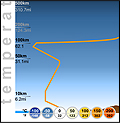 Conditions in the atmosphere
Conditions in the atmosphere
 WebElements™ periodic table
WebElements™ periodic table Ozone in the atmosphere
Ozone in the atmosphere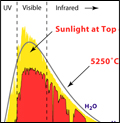 Kinds of sunlight that enters the atmosphere and makes it to the ground
Kinds of sunlight that enters the atmosphere and makes it to the ground
 Types of electromagnetic (EM) radiation
Types of electromagnetic (EM) radiation
 EM and climate:
EM and climate: EM and communication:
EM and communication: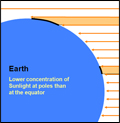 Concentration of sunlight received at different latitudes
Concentration of sunlight received at different latitudes
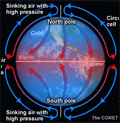 Explanation of general atmospheric circulation pattern on Earth
Explanation of general atmospheric circulation pattern on Earth
 Composite animation with significant features
Composite animation with significant features
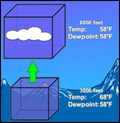 Why air cools as it rises and clouds form
Why air cools as it rises and clouds form
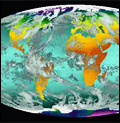 Clouds continuously forming over the ITCZ
Clouds continuously forming over the ITCZ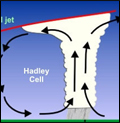 Clouds at the ITCZ and polar front
Clouds at the ITCZ and polar front
 Annual total rainfall across southern California
Annual total rainfall across southern California
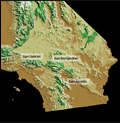 Elevation map of southern California
Elevation map of southern California
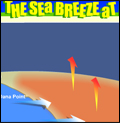 Air rising as air heats and a seabreeze develops
Air rising as air heats and a seabreeze develops
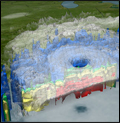 Where air rises in a cyclone
Where air rises in a cyclone Hurricane Emily activity
Hurricane Emily activity
 Historical map of downtown San Diego
Historical map of downtown San Diego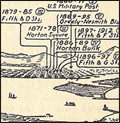 Location of early weather stations
Location of early weather stations
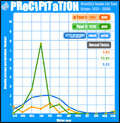 San Diego precipitation 1849-present
San Diego precipitation 1849-present
 Hatfield the rainmaker
Hatfield the rainmaker
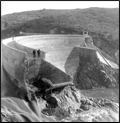 Early dam failures in San Diego
Early dam failures in San Diego
 Falling through air
Falling through air Falling through a thunderstorm
Falling through a thunderstorm Halo jumping
Halo jumping
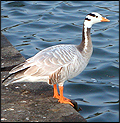 Bar-headed goose
Bar-headed goose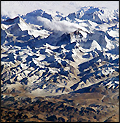 Himalayas from space
Himalayas from space
 Countries around the Himalayas
Countries around the Himalayas
 Map of the world - ETOPO1
Map of the world - ETOPO1
 No O2, no burning fuel - how high can planes fly?
No O2, no burning fuel - how high can planes fly?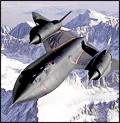 SR-71 Blackbird
SR-71 Blackbird
 Ares V rocket
Ares V rocket
 Coriolis activity
Coriolis activity
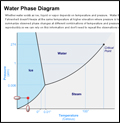 Phase changes - H2O
Phase changes - H2O